
Photo: Commincations Section: 398th AAA AW Bn (SP)
Top row, left to right: Gaudette, Ross, Beck, Fingerhut.
Bottom row, left to right: Todesco, Euart, Funk, Tighe.
It was April of 1944, when the long awaited orders came for my U.S. Army unit to cease its training activities and to head for the Port of New York for embarkation. We were going to Europe!
It seemed clear that the anticipated "second front" to invade Hitler's fortress Europe would soon be opened, and we were needed!
By "we," I refer to the 150 men of Battery B, 398th AAA AW BN (SP). The alphabetical mishmash was our mailing address. More formally, were identified as the 398th Anti-Aircraft, Automatic Weapons Battalion (Self-Propelled). Our assignment would be to shoot down any low flying enemy planes that would attempt to bomb or strafe our armored or infantry columns, artillery positions, bridges or supply depots. For this purpose, we were armed with quadruple .50 caliber machine guns and rapid-fire 37mm cannons attached to revolving turrets. These electrically operated turrets were mounted on armored half-tracks -- that is, vehicles equipped with two rubber tired wheels in front and tank-type tracks in the rear. The units were quite fast, extremely mobile and offered tremendous fire power.
When the call to action came, we had been practicing with these half-tracks for about six months at Camp Edwards, a large military base on Cape Cod, south of Boston. Cape Cod is supposed to be a beautiful summer vacation area. Our experience had been that it was hellishly cold in winter with freezing winds that blew in snow and sleet from the frigid waters of Buzzards Bay on one side and the open Atlantic ocean on the other.
Fortunately, I had found it to be an interesting change from the climate where I had undergone the Army's basic training. That was at Fort Eustis, Virginia, near Williamsburg. That is also supposed to be a beautiful vacation area -- but not, of course, in midsummer when I was there taking 20 miles hikes and running obstacle courses in the sultry, steamy swamps of the Charles River.
Between these two extremes, I had spent a delightful three months at the Army's signal corps school at For Monmouth, near Red Bank, New Jersey. The instructors there were men from the RCA Corporation's nearby research laboratory where they were working on some newfangled electronic device called "television," which we had never seen.
We were taught the basics of AM and FM radio and how to use vacuum tubes, resistors and condensers in electrical circuits. After graduating from this course in basic radio operation and repair, we each had an interview with an instructor who offered us two options for further technical training. He told us that we could specialize in either FM radio repair or something that sounded to me like "Rate R." I decided to go with the RM radio training since it seemed to be a technology that could be valuable after the war.
Later, I found out that the instructor's pronunciaton was bad and that what I understood to be "Rate R" was really something called "Radar," a new technology being used by the British in the air battle over Britain. I also found out that if I had selected Radar I would have gone into the army air corps as a radar operator and would have spent the winter training in balmy Palm Beach, Florida, rather than being in an armored anti-aircraft outfit in icy Cape Cod.
But that was history. Now we were on our way to Europe.
No comments:
Post a Comment